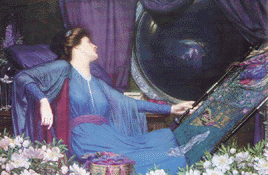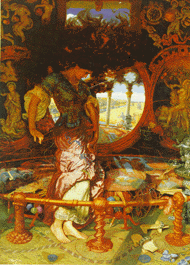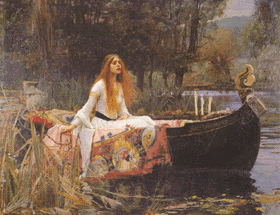Below are links to several paintings inspired by Tennyson's poem. You may write extra credit or exam essays about the illustration(s) of your choice (some of them make excellent contrasts to each other). How do aspects of the drawings reflect various themes and features of the poem?
I've tried to preserve the quality of the illustrations; some will download quickly, but others may take up to a minute with a 28.8K modem, 30 seconds with a 56K. Please be patient!

View A Detailed Version (406K)
This painting depicts the moment in lines 70-72 when the Lady saw "two young lovers lately wed" reflected in her mirror and declared, "I am half sick of shadows." Contrast this illustration with the next two by Hunt and Waterhouse to visualize the poem's tension between withdrawal and worldly activity/vibrant life.

View a Larger Version (179k)
View a Detailed Version (705K)
This painting depicts the sequence in lines 109-117 when the Lady's woven tapestry broke from the loom and "floated wide" after she saw Lancelot and dared to look down to Camelot. There are actually two versions of this painting with different backgrounds. In the "Larger Version," the pictures on the wall behind the Lady depict a King (possibly Arthur). In the "Detailed Version," the Lady's pictures show a remarkable contrast--on one side of the room is a picture of the Virgin Mary and Christ Child; on the other side is a picture of the Greek myth of Hercules stealing the Golden Apples. Consider how this symbolism relates to the dual themes of the poem and motives of the Lady. For more information on this painting, click here.
View a Detailed Version (54K)
This is Waterhouse's first painting of the Lady (see his second below). Note that like Hunt (above) Waterhouse depicts the Lady as caught in the threads of her tapestry.

View a Larger Version (121K)
View a Detailed Version (609K)
Waterhouse's second depiction of the Lady portrays the scene when she set sail for Camelot in her funeral barge while singing her final lament (lines 123-144). Compare to Riviere's version of the funeral barge below.
View a Detailed Version (193K)
Riviere's version of the funeral barge depicts the Lady after death. Contrast with Waterhouse's version of the barge above.
View a Detailed Version (198K)
Florence M. Rutland's drawing belongs not to the PreRaphaelite movement but to the Decadent/Aesthetic movement of the 1890s (to which writers such as Oscar Wilde belonged). Her drawing was published in 1896 in The Yellow Book, the central periodical publication of the Aesthetes (often considered a scandolous publication). The drawing depicts the moment when the Lady's tapestry broke (compare to Hunt's and Waterhouse's illustrations above).

BACK TO ART PAGE